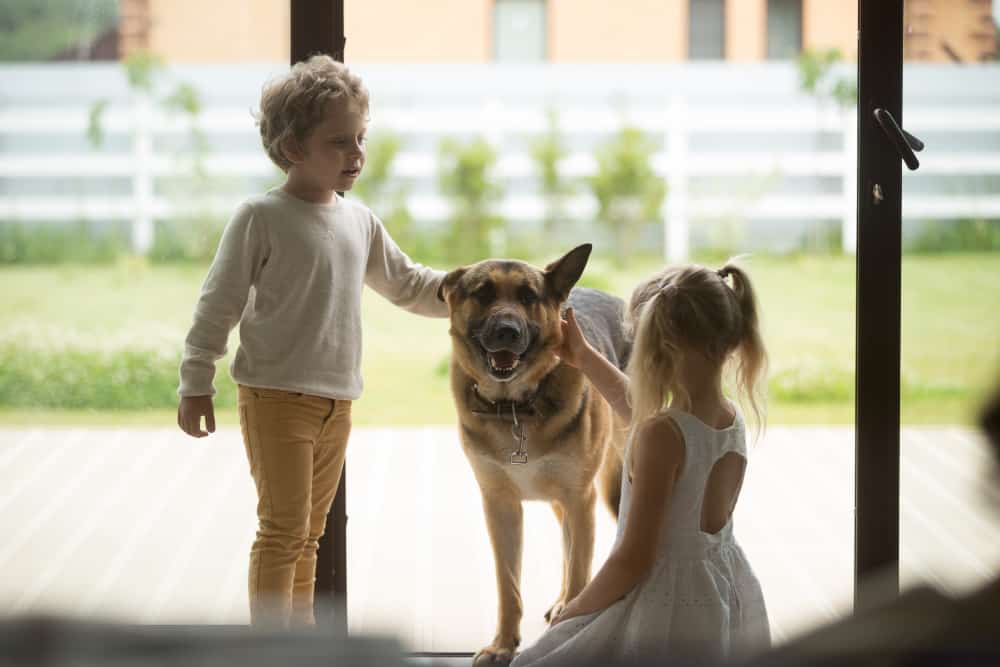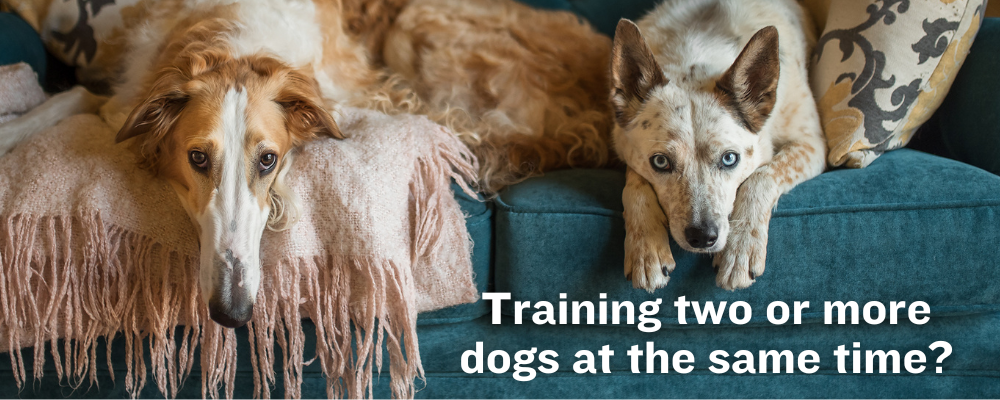German Shepherds are large and powerful dogs. They are sometimes too powerful to be around small children because they may jump on and knock over a child if not properly trained. GSD puppies are also notorious for being very mouthy and may easily hurt your child if they get too excited. Teaching your kids or even grandkids the appropriate manner to approach a new dog can be life-saving.
Key Takeaways (to let any kids know before playing with a dog)
| 1. Always be respectful to a dog 2. Be calm and gentle at all times 3. Learn to understand a dog’s body language 4. Never put their face near the dog’s face 5. Do not hug or kiss the dog suddenly 6. Never poke, squeeze, or pull at the dog 7. No rough play or chasing whatsoever 8. Stay away from the dog’s food or water |
In this article, we will share with you the best ways to teach your children how to treat your dog respectfully as well as introduce your German Shepherd dogs or puppies to your children or grandchildren to avoid any unwanted behavior from your dog.
Dogs are good for children’s mental and physical health
Children who are fortunate enough to have dogs in the household will enjoy the affection and unconditional love from the furry family member – this will continue to serve them well throughout their lives.
Children and dogs can build wonderful bonds. And a new puppy entering the family can be one of the happiest and most unforgettable memories for any child.
According to AACAP, the American Academy of Child & Adolescent Psychiatry, pets can provide the following benefits to children:
- Teach empathy and compassion
- Provide love, loyalty, and affection
- Foster self-esteem
- Promote physical activity
- Teach responsibility
- Provide valuable life lessons
- Provide a connection to nature
On top of that, if dogs are introduced in a child’s early life, these kids are much less prone to developing pet, grass, ragweed, or mite allergies later in life, according to Web MD.
Children who live with dogs are at higher risk of being bitten
However, there are some disturbing statistics on dog bites in the United States, especially when it comes to dogs biting children:
More than 4.5 million people are bitten by dogs each year in the United States, and more than 800,000 receive medical attention for dog bites. At least half of those bitten are children.
U.S. Centers for Disease Control (CDC)
And the fact is, 70% of children that are bitten by a dog are actually bitten by a dog in the household. Therefore, it is very important to teach your children as well as your dogs how to interact with one another before it’s too late.
Before introducing your children to your German Shepherd
Before the first encounter, there are a handful of things you need to do in order to get your dog ready. After all, these are the protocols to make the introduction safe and under control for the best interest of your children:
Make sure your dog’s vaccinations are up to date
It is extremely important that your dog is up to date on all of their vaccinations prior to being around children.
Socialize your puppy or German Shepherd puppy
When you first get your puppy. You should introduce them to babies, toddlers, and children of all other ages. If they come across kids at this stage, then they’re much more likely to accept them as normal.
Teach your German Shepherd puppy basic commands such as SIT and STAY
It is important that your dog understands the command of SIT and STAY before introducing them to your child. This is a reminder to your dog that they understand obedience and are under your command.
Crate train your German Shepherd puppy
Crates help dogs learn to self soothe, or deal with their anxiety, during situations where they may become distressed, like during meeting new people, or stressful situations.
Dogs can retreat to their crates when situations are too chaotic or scary. (Such as around noisy children) It also helps dogs confront new situations successfully, like the addition of a new baby (or your grandchild) having company over. (Source: AKC)
Provide a safe space for your German Shepherd puppy
Always respect a dog’s right and desire to withdraw, and allow them to do so. This means as an owner, you should provide your pup with a “safe space” for them to retreat to. This could be their crate or under a bed or a table.
Things to teach your child before meeting your German Shepherd
This process can be wonderful and exciting, but we should proceed with caution when introducing our children to new dogs.
Thankfully, teaching our kids the appropriate manner to approach new dogs can greatly reduce the chance something bad will happen.
Below are the DOs and DON’Ts when introducing your child or grandchild to a German Shepherd dog/pup:
The DOs
#1 Always be respectful to a dog
It is very important to teach your child to be respectful to your dog’s space as well as possessions. This simply means to behave nicely with them.
Dogs don’t like their tails being pulled. They don’t like having their ears tugged. No dogs like to have your child lying right on top of them.
Your children should be taught to respect your dogs when they choose to walk away, they’re asleep and wanted to be left alone.
#2 Be calm and gentle at all times
As a herding breed, German Shepherds have a natural instinct to chase, grab and bite fast-moving animals or objects. German Shepherds will always get mouthy when they get too excited.
Any quick movements with your limbs may also trigger this chain of action. So when a pup is in the house, your children will need to be calm and gentle at all times.
#3 Learn to understand a dog’s body language
One of the best things you can do is to educate your child on the body language that a dog exhibits.
For example, a bow post means your dog is ready to play. While a tail tucked between the legs could mean the dog is scared. You need to teach your child to pick up the signals from your dog’s body language in order to tell when it’s okay to approach a dog or to leave it alone.
In this video below, you can show your kids to learn how to interpret a dog’s body language:
The DON’Ts
#4 Never put their face near the dog’s face
Children are at a high risk of being bitten in the head, face, and neck by a dog. Therefore, it is important that you educate children to not put themselves at risk by placing their head near the dog’s head. This simple advice can prevent a catastrophic or disfiguring injury to the child.
#5 Do not hug or kiss the dog suddenly
It is common for a child to want to hug or kiss a dog. But you need to explain to your child that a dog is not a stuffed toy. Many dogs do not enjoy being hugged or kissed. They can feel uncomfortable and even show aggression from this type of human affection. Let children know that hugging or kissing your dog is not allowed.
#6 Never poke, squeeze, or pull at the dog
It is natural for children to want to play with a dog they meet. Many children will want to poke at your dog or even pull their fur or tail. Make sure they know that these types of behaviors are unacceptable and may let your dog feel intimidated and result in a bite.
#7 No rough play or chasing whatsoever
Kids will naturally pull back and a puppy will keep tugging. There may be a time when arms and legs get bitten in the process. If it is not a behavior you want, it should never be encouraged in play.
Kids also love to run around. But when it comes to a herding breed like the German Shepherds, any fast-moving motion may trigger their prey drive so they will bite or grab by instinct. You should let your child understand no rough play of chasing should be allowed at all times when your pup is present.
#8 Stay away from the dog’s food or water
A child should never go near a dog’s food or bother a dog while the dog is eating or drinking. German Shepherds have resource guarding instincts and may become aggressive when their food and water are being disturbed.
Craving the very first Interaction
It’s well worth taking the time to ensure these first interactions go as smoothly as possible so that both dogs and your children can get to know each other safely and comfortably.
Put a leash on your pooch
It’s a good idea to put a leash on your pooch to keep the dog under control at first. In this way,you will be able to regain control if things get a little wild.
Let your dog approach the children first
Rather than allowing your child to come to the dog, let your dog approach the children first. Ask your children to sit calmly and quietly and don’t stare directly at the dog’s eye. This allows your pooch to watch your kid without feeling overwhelmed and greet your kid on his or her own terms.
It’s important to allow your dog to approach and sniff your child’s hand without reaching out to them. If your dog seems relaxed and comfortable then you let your child pet the dog on the back.
Once your dog and your children feel comfortable around each other and start bonding, they’ll become companions for life.
Remind your children to take it slowly
You can explain to them that your new dog is in a new and unfamiliar environment. He may feel restless, uncomfortable, or intimidated being away from his littermates. So he may become grumpy if your child is too excited.
Remind your child to stay calm. Sudden body movements can easily frighten a pup and cause them to protect themselves by biting or nipping.
If your children aren’t used to dogs, then they may get frightened. So be ready to move the dog away if it gets too much. Likewise, if the dog starts showing signs of unease such as growling, separate them and try again another time when your dog is ready.
Supervision closely and watch for signs to intervene if necessary
Watch out for all signs your dog is not yet ready to interact with kids. Remove your dog immediately at any sign of aggression. If your dog begins to bark, acts agitated or scared, or engages in aggressive behavior, then it is your responsibility to immediately remove the dog from the situation.
What you can teach your kids to do with your dog
Involving children in the dog’s care can be a meaningful experience for the entire family. For example, you can let your kids take the dog on its evening walk and clean up after it. It will help the children learn responsibility as well as bond with the dog.
Always supervise your German Shepherd and children’s playtime regardless (I cannot say that enough so might as well bold the entire section)
Always supervise your dog and your child’s interaction when they’re together. By supervision, we mean watching closely and correcting unacceptable behavior of either your pup as well as your child if necessary.
As a responsible owner, you should be able to pick up any early signs that your dog is getting stressed and intervene early. You need to be proactive to prevent things from getting too wild.
Active supervision should be a rule for babies, young toddlers, young kids, and even older children up to around 16 years of age.
Final thoughts
Being able to spend time with our favorite pets in our childhood is a blessing. Time and time again, dogs have become valuable members of our families, helping teach our children love, respect, responsibility, and gentleness.
We hope this guide will give you a good idea of how to introduce your child or grandchild to a German Shepherd in a way that can create the sweetest bond in the years to come.



